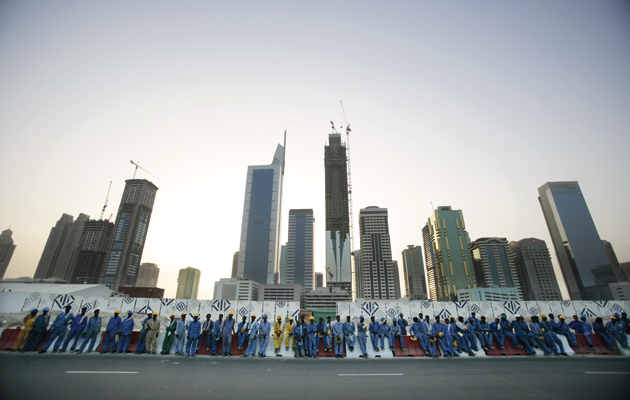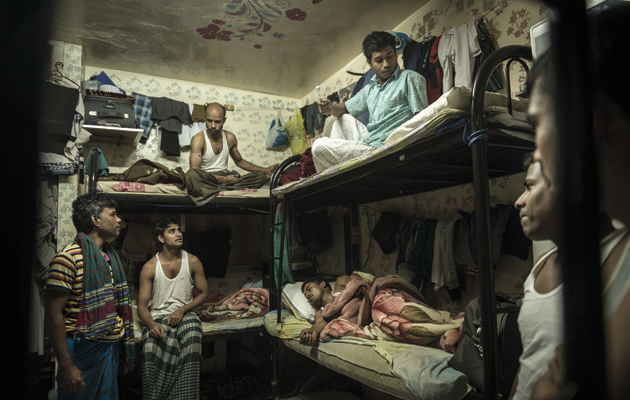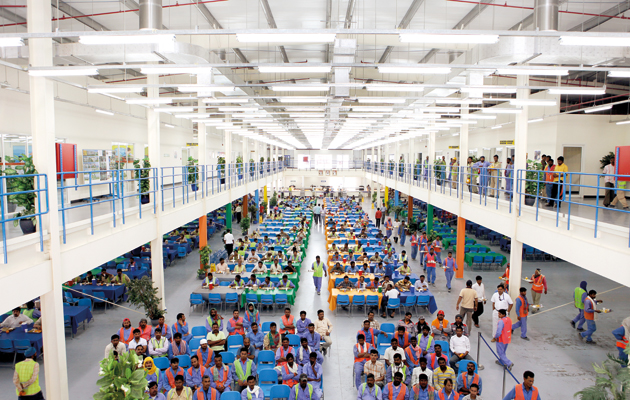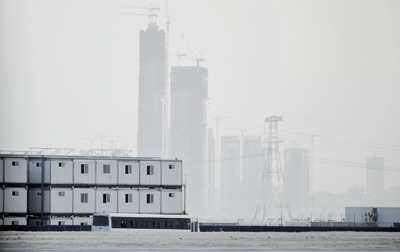|
|
||
|
Architects may not employ the migrant workers building their grand designs in the Gulf states, but their names lend credibility to those that do. With appalling conditions still rife in the region, human-rights groups are demanding that practices stand up to their paymasters Last year, two Pritzker laureates reignited a debate that has persisted since the start of the building boom in the Gulf states. Early in the year, Zaha Hadid provoked a media storm when she appeared to wash her hands of responsibility for working conditions on her World Cup stadium in Qatar. “I have nothing to do with the workers,” she said. “That’s an issue the government should pick up. It’s not my duty as an architect to look at it. I cannot do anything about it because I have no power to do anything about it.” In contrast, later in the year Frank Gehry revealed that his practice had been working closely with authorities to improve labour conditions on his Guggenheim Abu Dhabi project since a 2009 Human Rights Watch (HRW) report exposed exploitation of workers on the $27 billion Saadiyat Island development, of which the museum is part. “Gehry Partners has been engaged in a substantial and on-going dialogue over many years that has involved government, the construction industry, architects, project, sponsors and NGOs,” said the firm, naming as priorities health and safety, access for workers to their passports, contractor accountability, independent site monitoring and the abolition or reimbursement by employers of the steep recruitment fees paid by many workers. “It’s not a legal responsibility, but it’s a moral responsibility,” Gehry’s lawyer Scott Horton told Architectural Record in September. Gehry is evidently keen to avoid the human-rights abuses connected with other projects in the Gulf. Perhaps he is also wary of the reputational damage that any abuses on the Guggenheim site – or at least public revelations about them – may cause his firm. But whether you believe the motive for his stance is labour emancipation or avoiding embarrassment, he remains one of the few architects to publicly address the issue of working and living conditions on their own project in the region. |
Words Debika Ray
Above: Migrant construction workers in Dubai line up to board a bus back to their labour camp, over two hours away
Images: Brent Stirton/Getty images; Sergey Ponomarev/ eyevine; STR/AFP/Getty; Rich-Joseph Facun; Andrew Parsons/AP/Press Association |
|
|
||
|
Bangladeshi workers share a room in an apartment in Abu Dhabi |
||
|
Rights groups have consistently reported the widespread exploitation in the Gulf region of migrant workers, who travel to countries such as the UAE and Qatar to work, and end up labouring in slave-like conditions, with punishing hours, squalid, overcrowded living quarters miles from site and few employment rights. Saadiyat Island itself has faced further criticism of its working conditions in recent years. Yet architects continue to design for the regimes under which these abuses occur. “Starchitects have acted with breathtaking contempt for the lives and wellbeing of the migrant workers building their spectacular culture shops, from which they profit so handsomely,” says writer Guy Mannes-Abbott, who campaigns for Gulf Labor, a group working to expose exploitation on Saadiyat Island.
The Khalifa Stadium in Doha undergoes renovation in preparation for the 2022 World Cup in Qatar Yet, in some respects, Hadid is right. Architects are not responsible for hiring construction workers, so are not in a position to dictate employment conditions. You could also argue that they cannot dismantle the complex system that incorporates workers into the Gulf’s construction sector. The treatment of the predominantly South Asian migrants who build these city-states is a result of a combination of local factors, such as the social and racial hierarchies of the Gulf states, and global ones, including the fragmentation of the construction supply chain in recent decades, removing accountability for labour from the top levels of management, and a reliance on vulnerable agency workers to cut costs. Indeed, worker exploitation is not unique to this region, as recent wrangles over “gangmaster” licensing in the UK have demonstrated. But architects who take on work in the Gulf do so knowing its record on human rights, and that construction there is linked to the exploitation of workers – particularly through the ban on collective bargaining and the kafala system of sponsorship, under which migrant labourers are tied to a single employer. Moreover, the prominent role of famous architects in developing the Gulf means it is disingenuous to claim powerlessness. “High-profile individuals are brought on board to lend credibility to projects, which affords them great power to set out the conditions of their involvement,” says Nick McGeehan, author of a third HRW report about Saadiyat Island published last month. “They have far greater influence than they’ve exerted to date.” |
||
|
Workers in Dubai wait for a bus after a 12-hour shift |
||
|
This is particularly true of Abu Dhabi. When completed in 2020, the government-funded Saadiyat Island will contain an unprecedented number of schemes by architectural superstars, including Gehry’s Guggenheim, Hadid’s Performing Arts Centre, Norman Foster’s Zayed National Museum, Jean Nouvel’s Louvre, Tadao Ando’s Maritime Museum and Rafael Viñoly’s outpost for New York University. “Abu Dhabi wants to buy prestige, and why not?” says Mannes-Abbott. “If architects say no, not under the conditions of forced labour, it cannot.” Yet few are willing to speak out. While Foster told Icon that his practice was following the lead of its client to “promote the highest standards of welfare for the workforce”, Hadid, Nouvel and Viñoly did not respond to requests to comment. Even Gehry and his lawyer would not go on the record for this article. This reticence suggests that architects are focused more on protecting their reputations than on pushing for change, and it calls into question how much pressure they are really exerting behind the scenes. Although it is believed that Gehry has been discussing workers’ rights since the start of his involvement in the project, it is not clear whether he has put explicit conditions on the client in exchange for his involvement. Could such a conciliatory yet cautious approach be, as Mannes-Abbott describes it, “face-saving PR”? |
||
|
Inside Saadiyat Accommodation Village in Abu Dhabi |
||
|
Saadiyat Island is central to the emirate’s mission to establish its image as a globalised, sophisticated, tourist-friendly metropolis. This has involved attempts to distance itself from the criticism other Gulf projects have faced. In 2009, responding to concerns of rights groups, the developers and institutions associated with Saadiyat Island made public promises to improve conditions, introducing codes of conduct and establishing a system of independent monitoring of working and living conditions. In addition, TDIC – the developer of the Guggenheim and the Louvre – built a dedicated facility to provide an “internationally recognised world-class standard of living for workers”. Saadiyat Accommodation Village (SAV) – a name designed to shake off the negative connotations of the word “camp” – features a well-manicured cricket oval, a gym, a games room and a multi-lingual library. But subsequent reports by HRW in 2012 and this year, and another by Gulf Labor last year, both reported continuing problems on the island. “Every time an independent body goes to Saadiyat, we find problems,” McGeehan says. Last year, Gulf Labor said that wages on the island were no better than on other comparable projects and encountered continuing reports of passports being withheld, recruitment fees not being repaid and insufficient grievance mechanisms. TDIC and New York University remain adamant that progress has been made in meeting their codes, with recruitment fees reimbursed, passports held only with permission, timely payments, better housing and an enhanced grievance system. But McGeehan is satisfied that, despite improvements, abuse continues, mainly because sanctions on contractors are not strong enough. His most recent report documents similar problems, as well as instances of worker unrest. “A few workers appear to have instigated strike action, then a large number were arbitrarily sent home without due process,” he says. Following its publication, TDIC said it “rejects the report’s unfounded conclusions, which are outdated and based on unknown methodologies“, while New York University said it was unable to provide a comprehensive response without more details about its findings.
TDIC’s Saadiyat Accommodation Village in Abu Dhabi (above and below) Realities on the ground reveal the structural underpinnings of this worker exploitation. Despite improvements in housing quality, migrant workers remain on the peripheries of society. According to Gulf Labor’s 2014 report, SAV is located 2km beyond a checkpoint that casual visitors cannot cross. The facility is blocked off from the city by the building site, and linked to a main road only by hourly shuttle buses from the checkpoint. In the few photos that exist, the “village” resembles barracks. And the reality has not always lived up to promises. Although the SAV was designed to accommodate 20,000 and TDIC says that 96 per cent of workers are now housed there, Gulf Labor reported that on its last visit there were a mere 6,000 occupants because some contractors were preferring to avoid the facility’s higher than average rents, housing some workers elsewhere. McGeehan also found workers who were living on alternative and inadequate sites. It’s not easy to get the full picture. McGeehan says he has been banned by the UAE authorities from returning to the country. It is possible that such moves to control information, and the greater interest over the past year in visibly improving conditions on Saadiyat Island through codes of conduct and independent monitoring, are a response to rising pressure by the International Labour Organisation to allow a large-scale investigation of working practices in Abu Dhabi. Its report on Qatar elicited promises from the state to overhaul kafala and increase enforcement of existing laws. And what of the state’s role in Abu Dhabi? Gehry is understood to be focusing on creating a contractual basis for enforcement of codes and laws. As most parties agree that the problem lies with lack of enforcement rather than legislation, this may seem to make sense. Yet voluntary codes and contractual mechanisms often have limited impact beyond individual projects. “Codes of conduct are a stepping stone to state regulation,” McGeehan says. “Sadly, we’re yet to see anyone really playing hardball with the Gulf states and saying that, if you want me involved, I need assurance that things will change, not just on my project but elsewhere.” This article first appeared in Icon 141: Camps, under the headline “Dirty work”. Buy back issues or subscribe to the magazine for more like this |
||
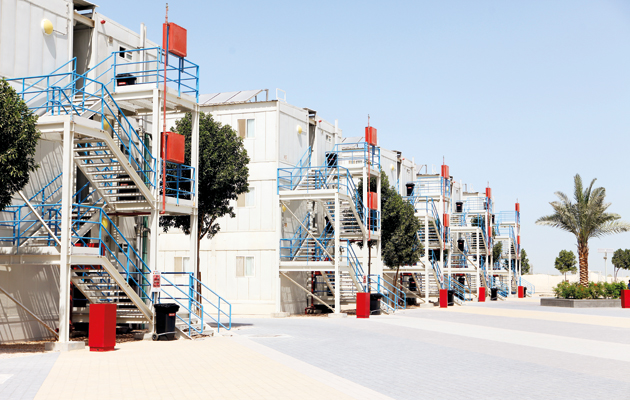 |
||

